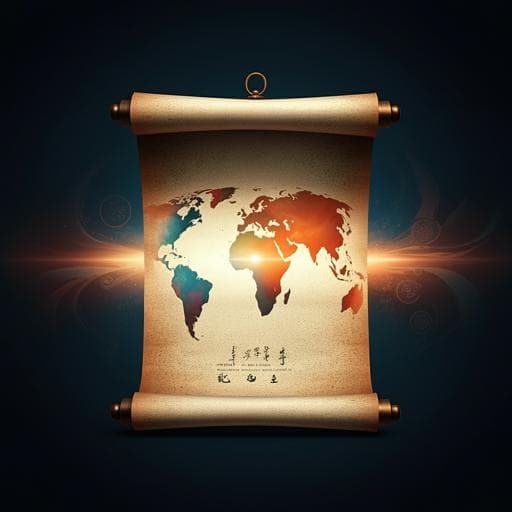
Humanities
Bringing in' and 'Going abroad': A bibliometric evaluation of the internationalization of archaeology in Mainland China
X. Wei, W. Lou, et al.
This research conducted by Xuan Wei, Wentai Lou, Ting Li, Ruxi Yang, and Yinghua Li delves into the internationalization of archaeology in Mainland China, revealing trends in publication increase but noting a still-small proportion compared to domestic journals. It highlights the need for ongoing observation amid changing policies.
~3 min • Beginner • English
Introduction
The paper examines the internationalization of Chinese archaeology, situating it within a century-long trajectory from sporadic early interactions to accelerated engagement after the 1978 Reform and Opening-up. It outlines relevant national policies (e.g., foreign-related archaeology regulations, "Going Out" plan, Belt and Road Initiative) and institutional developments (e.g., the Center for Foreign Archaeological Research at IA CASS) that fostered diverse international activities, including collaborations, translations, overseas fieldwork, and publications in international journals. Leveraging bibliometric approaches, the study poses four research questions: how well Chinese archaeologists were informed about the international community; the degree and performance of internationalization and coupling with international frontiers; the extent and roles in international collaboration; and characteristics of journals where Chinese scholars publish. The purpose is to provide a quantitative, macroscopic evaluation of internationalization patterns and trends in Mainland China’s archaeology.
Literature Review
The authors review the rise of bibliometric, scientometric, and informetric methods as established tools for quantitatively assessing scholarly communication, performance, and disciplinary trends. Prior applications in archaeology have addressed subfields and topics, and recent work has provided macroscopic reviews of Chinese archaeology using CNKI and WoS datasets. Within internationalization studies, literature frames internationalization at national, institutional, and individual levels, emphasizing journal articles as analyzable outputs with indicators such as international collaboration, research content, coupling with global issues, and journal impact. The study builds on this literature by focusing on translated content, original foreign archaeology articles, and WoS-indexed publications by Mainland Chinese archaeologists, using keyword co-occurrence, collaboration typologies, and journal metrics to assess internationalization.
Methodology
Data sources: CNKI (Chinese core journals indexed by CSCD 2020, CSSCI 2020, CCP-PKU 2020) and WoS Core Collection (SCI, SSCI, A&HCI). For CNKI, 27 Chinese Core Journals (CCJs) relevant to archaeology/history/geology were included, totaling 40,865 articles (to 2021-12-31). For WoS, archaeology-related keywords (archaeolog*, paleoanthropolog*, prehistor*, paleolithic*, neolithic) and affiliation filters (Peoples R China/China/Hong Kong/Macao/Taiwan) yielded 3,182 archaeology-related articles after removing non-archaeology topics (to 2021-12-31, including in-press). The analysis excluded museum management, heritage protection, and ancient architecture. For leadership attribution and main analyses, only papers where the first or corresponding author was affiliated with Mainland China were considered.
Data processing: Excel, VOSviewer (v1.6) and CiteSpace (v6.1 R6) were used. VOSviewer was used for co-authorship network visualization at the organization level (all counting; thresholds in institutional overlay: minimum 10 documents and 10 citations, yielding 89 organizations and 782 links). CiteSpace parameters for keyword analysis: Node types = keyword; Time slicing 1980–2021, 5-year slices; defaults otherwise. Comparison of keyword hotspots used all archaeology-related WoS papers (103,840) versus Mainland China-authored WCJ subset. Highly productive and highly cited authors were analyzed via CiteSpace Node types = Author and Cited Author, respectively, with a timeline and cluster view for cited authors.
Screening steps: From CNKI, translated articles (n=734) were identified and categorized into three types: foreign archaeological research; foreign archaeological theory and method; Chinese archaeological studies conducted by foreign researchers. Original articles on foreign archaeology (AFAs) by Chinese authors were identified in CCJs (n=488) and WCJs (n=103), and their countries/regions and links to Sino-foreign field projects were recorded; 49 AFA papers directly reflected Chinese-led foreign field projects (33 excavation reports, 16 original articles; 45 in Chinese, 4 in other languages). From WoS, collaboration types were classified: N-ICA (all authors from Mainland China), ICA (at least one author from outside Mainland China), and a special category (authors from Mainland China with others from Hong Kong/Macao/Taiwan). ICA was further categorized by first/corresponding author affiliation: Mainland China-led, Other-led, and HK/Macao/Taiwan-led. Journal characteristics were assessed using JCR (2021) for WoS Categories and JIF quartiles (SCI/SSCI; ESCI and A&HCI recorded as such).
Inclusion principle: The study emphasized papers in which the first or corresponding author's affiliation was in Mainland China, on the assumption that these roles typically reflect lead contribution.
Key Findings
- Corpus and filtering: 44,047 archaeology papers collected (40,865 CCJs; 3,182 WCJs). After filtering, 734 translated articles; 591 original articles on foreign archaeology (AFAs: 488 CCJs; 103 WCJs); and 2,260 WCJ articles with first/corresponding author from Mainland China.
- Translated articles: 734 translations comprise 1.8% of CCJ papers. Content split: 49% foreign archaeology; 26% theory/methods; 25% Chinese archaeology by foreign researchers. Country of origin for translations spans 40 countries, with Japan (~209) leading, then USA (188), Soviet Union (76), England (52), Russia (48), Canada (39). Journals publishing most translations include Cultural Relics in Southern China (165), Northern Cultural Relics (110), Agricultural Archaeology (77), Archaeology (76), Archaeology and Cultural Relics (39), Huaxia Archaeology (39), Southeast Culture (36). Three peaks in translation output: late 1950s–early 1960s; 1980s–2000; and the last decade (notably in Cultural Relics in Southern China after 2005).
- AFAs (original foreign archaeology by Chinese scholars): 591 total (1.24% of all archaeology papers), with 488 in CCJs (1.2% of CCJs) and 103 in WCJs (4.6% of WCJs by Chinese scholars). Focus skewed to neighboring regions (Japan, Korea, Russia, Southeast Asia, Central Asia), with some Europe/Africa attention and little to West Asia/North America. AFAs rose notably after 2013 (BRI), with 2021 counts of 19 (WCJs) vs 1 (CCJs). Of 49 papers tied to Chinese-led foreign field projects, 45 were in Chinese; document types: 33 excavation reports, 16 research articles.
- WCJ publication trend: 2,260 WCJ articles by Mainland China first/corresponding authors equal 5.24% of all Chinese archaeology papers (CCJ+WCJ). Early WCJ entries: 1980 (review on Chinese Neolithic, translated) and 1981 (Dali Man). Rapid growth in 21st century, peaking at 284 papers in 2020 (214 in 2021).
- Keyword hotspots and coupling with global frontiers: High-frequency keywords in Mainland China-authored WCJ papers include neolithic age, north/central China, yellow river, homo erectus, and, post-2000, climate change, evolution, agriculture, bronze age, domestication, origins, late pleistocene, environmental change, ancient dna; post-2010 expansions include tibetan plateau, silk road, stable isotopes, luminescence, starch grains, radiocarbon dating; post-2020: food globalization, genetic/population history, human–environment interactions. Comparison of top-20 keywords with global WCJ archaeology shows eight shared hotspots (archaeological site, climate change, origin(s), evolution, late pleistocene, site, ancient dna, history), indicating strong coupling with international frontiers.
- Influential Chinese authors: Most-published: Xing Gao (79); other high-output authors include Houyuan Lu (39), Changsui Wang (35), Guanghui Dong (34), Hui Zhou (33). Most-cited: Houyuan Lu (269), Zhijun Zhao (224), Xing Gao (193), Fahu Chen (182), Guanghui Dong (147), etc. Timeline clusters show major themes such as Chinese Paleolithic, molecular genetics (many influential authors post-2018), East China studies post-2010, central China and hominin teeth themes from earlier periods, and numerous influential scholars emerging after 2000.
- Collaboration types in WCJs (n=3,182 with Chinese authors): ICA 1,915 (60.2%); N-ICA 1,167 (36.7%); special Mainland China + HK/Macao/Taiwan 100 (3.1%). Leadership: Mainland China-led 2,260 (71% = 1,167 N-ICA + 1,075 Mainland China-led ICA + 18 special Mainland China-led); Other-led 807 (25%); HK/Macao/Taiwan-led 107 (4%).
- Institutional collaboration networks: With thresholds (≥10 docs and ≥10 citations), 89 organizations (62 Chinese, 27 international) and 782 links. CAS (especially IVPP) anchors the network, collaborating closely with Peking University, Jilin University, Fudan University, China University of Geosciences, Yunnan University, Lanzhou University, Nanjing University, and others. Top Chinese institutions by WCJ documents: CAS 822; Peking 168; Jilin 132; CASS 124; Lanzhou 107; Fudan 96; Nanjing 96. Top foreign collaborators include UCL (49), Washington University (34), Harvard (32), University of the Witwatersrand (28), University of Hawaii Manoa (26), University of Oxford (26), University of Arizona (24), Max Planck Institute for the Science of Human History (22). US-based institutions constitute nearly half of the top-20 foreign collaborators.
- Journal disciplinary and geographic distribution: 2,260 papers in 395 journals across 57 WoS Categories; only 39 archaeology sensu stricto journals (605 papers). Most outputs appear in multidisciplinary journals (1,241 papers in 104 journals) and geosciences (871 papers in 54 journals). Host countries: UK (832 papers; 103 journals) and USA (475; 90) dominate; Mainland China journals (64) account for 444 papers, with Chinese Archaeology (ESCI) the only archaeology sensu stricto journal hosted in Mainland China within WoS core.
- Journal impact (JIF quartiles, 2021 JCR): Q1 40%, Q2 36%, Q3 6%, Q4 6%, ESCI 5.6%, A&HCI 5.8%. ICA papers concentrate in Q1 (1,039) and Q2 (557); N-ICA concentrates in Q2 (458) and Q1 (347), with ESCI (113) largely Chinese Archaeology. Q1 article totals rose markedly in the last decade.
Discussion
Findings indicate significant growth in the internationalization of Mainland China’s archaeology, reflected in rapid increases in WCJ publications, strong alignment with global research frontiers (e.g., climate change, ancient DNA, Late Pleistocene), and broadening, Mainland China-led international collaborations. Institutional networks are extensive but uneven, with CAS and leading universities central. Publication venues reflect strong interdisciplinarity, with a predominance of natural science journals and English-language hegemony (UK/US hosts). Despite advances, Chinese archaeology’s overall share in WCJs remains small relative to both global output and domestic CCJ volume. Policy drivers (e.g., "Going Out," BRI, evaluation systems favoring first/corresponding authorship and JIF) likely fostered increased Mainland China-led outputs and ICA in high-impact journals. Recent policies emphasizing domestic evaluation could tilt toward localization; the study suggests internationalization and localization should be balanced dynamically. Continued international collaboration, interdisciplinary methods, and increased visibility in high-impact venues are crucial for enhancing Mainland China’s archaeological presence globally.
Conclusion
Internationalization of archaeology in Mainland China has accelerated notably since the early 2000s, with rising WCJ outputs, expanded collaborations, and research topics that closely track international frontiers. However, it remains far from dominant: AFAs are few, and the proportion of WCJ publications authored by Chinese scholars is small compared to CCJ output and the global total. Three journal-related patterns stand out: a strong interdisciplinary orientation with emphasis on natural sciences; dominance of English-language venues in the UK and USA; and a growing trend toward publishing in high-impact journals, often via international collaboration. To further internationalize, the field may benefit from establishing more English-language archaeology journals hosted in China, strengthening high-quality international collaborations, and sustaining support for globally visible research. Future work could extend bibliometrics to monographs, theses, non-core journals, gender and institutional imbalances, and track engagement patterns between Chinese and foreign scholars to build a more comprehensive picture.
Limitations
- Data restricted to CNKI-indexed CCJs and WoS Core Collection (SCI/SSCI/A&HCI) through 2021-12-31; museums, heritage management, and ancient architecture topics were excluded.
- Focused on papers where the first or corresponding author is affiliated with Mainland China; articles solely from Hong Kong/Macao/Taiwan were excluded from main analyses.
- Some AFAs may have been omitted due to the limited journal set (27 CCJs; SCI/SSCI/A&HCI only). ESCI/A&HCI quartiles not available.
- Bibliometric focus emphasizes journal articles and may not capture other internationalization dimensions (e.g., monographs, theses, conferences, staffing, student exchanges). Raw dataset cannot be publicly shared due to CNKI and WoS licensing constraints.
Related Publications
Explore these studies to deepen your understanding of the subject.







